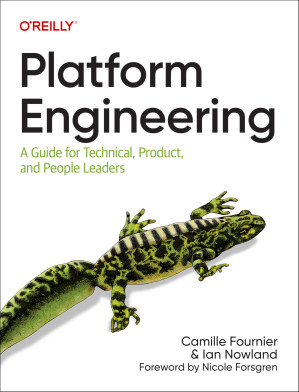Insights from Plaftform Engineering: A Guide for Technical, Product, and People Leaders
When I first came across the idea of platform engineering, I realised how critical it is for scaling organisations to manage shared infrastructure and tools effectively. Camille Fournier and Ian Nowland's Platform Engineering goes beyond theory, offering actionable strategies for building cohesive, user-centric platforms.
This book resonated with me as someone passionate about improving engineering systems. It provides a structured approach to handling platform challenges, from team organisation to operational excellence. If you're a leader in the tech space, this guide is a treasure trove of insights to streamline complexity while fostering innovation.

Summary
Part I: The What and Why of Platform Engineering
This section lays the foundation for understanding platform engineering, covering its definitions and necessity.
Chapter 1: Why Platform Engineering Is Becoming Essential
The authors detail how organisations have struggled with fragmented systems due to OSS and cloud adoption. They explain how platform engineering addresses these issues by reducing “glue work” and creating scalable, user-friendly systems.
Chapter 2: The Pillars of Platform Engineering
The book introduces four core pillars:
- Product: Platforms should be treated like internal products.
- Software: Platforms abstract complexity using well-designed APIs and tools.
- Breadth: Platforms serve diverse teams with different needs.
- Operations: Platforms prioritise stability and scalability.
Part II: Platform Engineering Practices
The heart of the book dives into practices for building effective platforms.
Chapter 3: How and When to Get Started
This chapter emphasizes starting small, focusing on real problems rather than jumping into tools or new architecture. It provides advice on identifying promising areas and ensuring cultural alignment.
Chapter 4: Building Great Platform Teams
The authors discuss roles within a platform team, including software engineers, systems engineers, and product managers. They highlight the importance of customer empathy and operational experience in building successful teams.
Chapter 5: Platform as a Product
This chapter underscores treating platforms as products by taking a customer-first approach. It covers roadmap planning, avoiding feature overload, and delivering value incrementally.
Chapter 6: Operating Platforms
Operational excellence is key to successful platforms. The authors delve into on-call practices, support processes, and operational feedback mechanisms like SLAs and change management.
Chapter 7: Planning and Delivery
Planning is critical for long-running platform projects. This chapter covers setting clear goals, roadmap planning, and balancing ongoing improvements with mandates and system updates.
Chapter 8: Rearchitecting Platforms
Rearchitecting platforms is often necessary as systems grow. The authors outline a structured approach, emphasizing compatibility, testing, and phased rollouts to minimize disruptions.
Chapter 9: Migrations and Sunsetting of Platforms
This chapter provides guidance on managing migrations and retiring outdated platforms. The focus is on minimizing disruption while coordinating smooth transitions.
Chapter 10: Managing Stakeholder Relationships
Stakeholder management is critical for platform success. The authors offer strategies for communication, expectation setting, and balancing priorities to build trust.
Part III: What Does Success Look Like?
The final section explores what success in platform engineering looks like.
Chapter 11: Your Platforms Are Aligned
Successful platforms align with organisational goals and foster collaboration between teams, balancing technical and business needs.
Chapter 12: Your Platforms Are Trusted
Trust is earned through reliability and consistent delivery. This chapter explores strategies for building trust through technical excellence and effective communication.
Chapter 13: Your Platforms Manage Complexity
Managing complexity is central to platform engineering. The authors discuss strategies for reducing accidental complexity and maintaining system clarity.
Chapter 14: Your Platforms Are Loved
The ultimate goal is to build platforms that are loved by their users. This chapter highlights the importance of user satisfaction, continuous feedback, and iteration.
Key Takeaways
Key Takeaway 1: Treat Platforms as Products
- Platforms must be user-centric and designed like external products, focusing on developer experience.
- Personal Reflection: This approach elevates platforms from support roles to enablers of innovation.
- Quote: “A platform is a foundation of self-service APIs, tools, services, knowledge, and support that are arranged as a compelling internal product.” – Camille Fournier & Ian Nowland (p. 4)
Key Takeaway 2: Simplify Glue Work
- Reducing “glue” (custom integrations) prevents maintenance nightmares and speeds up development.
- Personal Reflection: Glue work slows teams. This takeaway emphasizes building systems with clear abstractions.
- Quote: “Platforms constrain the amount of glue needed by implementing the concepts of abstraction and encapsulation.” – Camille Fournier & Ian Nowland (p. 6)
Key Takeaway 3: Operational Excellence is Key
- Platforms should simplify operations, enabling developers to focus on building features rather than fighting infrastructure issues.
- Personal Reflection: Simplifying operations makes developers more productive and happier.
Key Takeaway 4: Success Is Multi-Faceted
- Success isn’t just about technical achievements. Platforms must align with goals, earn trust, manage complexity, and be loved.
- Personal Reflection: This holistic view resonates as I’ve seen technically sound systems fail due to poor alignment or lack of trust.
Personal Reflections
This book redefined how I think about platform engineering. By focusing on user needs and operational excellence, platforms can transform organizational productivity. The insights on stakeholder management and migration were particularly impactful, as these areas are often overlooked but critical to success.
Conclusion
Platform Engineering is an essential read for leaders navigating the complexities of modern software development. By blending technical, organisational, and product insights, the book offers a roadmap to building platforms that deliver long-term value. If you're looking to scale engineering systems while empowering your teams, this book is a must-read.